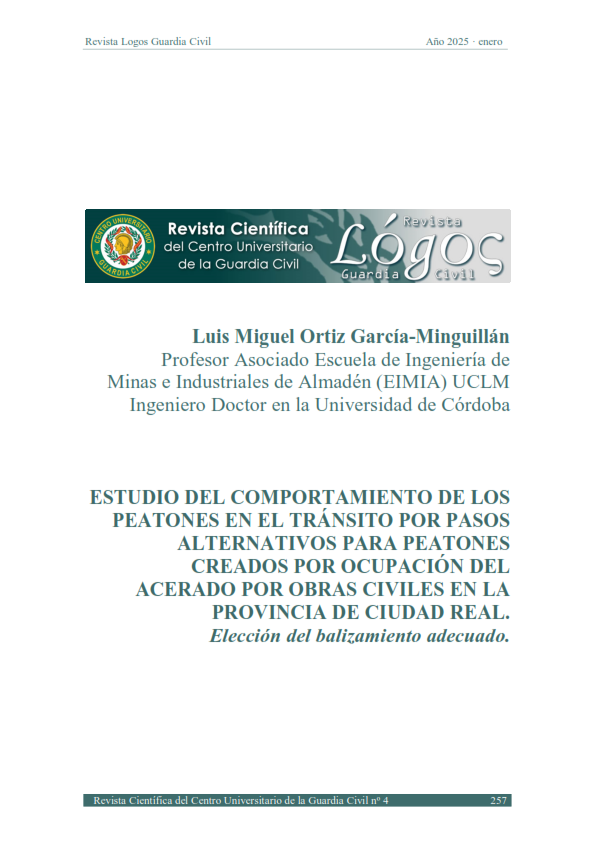Study of pedestrian behaviour when using alternative pedestrian crossings provided due to construction work occupying the pavement in the province of Ciudad Real.
Choice of appropriate beacons.
Keywords:
pedestrian accidents, planned behavior, pedestrian mobility, road safety, urban civil worksAbstract
Road hits and accidents are one of the leading causes of injuries with high percentages of disability and death in the world. On many occasions, pedestrian areas are invaded by works on the sidewalk and it is necessary to carry out an alternative passage on the road, increasing the risk of being hit. This article analyzes the transit of pedestrians through alternative steps on the road in situations in which electrical work is carried out on public roads that completely occupy the sidewalk. Three analysis models have been considered: based on the separation of pedestrian and vehicle areas, the density of road traffic and the activities carried out on the site. The experiments have been carried out in different towns in the province of Ciudad Real (Spain).
Downloads
References
Ashton S.J., Mackay G.M. (1979). Car design for pedestrian injury minimisation. Proceedings of the Seventh Experimental Safety of Vehicles Conference, Paris, 5-8 June 1979, pp. 630-640.
Conejera, M., Donoso, D., Moyano, E., Peña, J., Saavedra, F. (2003). Comunicación persuasiva y cambio de actitudes, hacia la seguridad de tránsito en peatones. Revista Latinoamericana de Psicología, 35(1), pp. 77-90.
Dirección General de Tráfico (2014). Los peatones. Subdirección General de Intervención y Políticas Viales. Unidad de Intervención Educativa. NIPO: 128-14-040-2.
Dirección General de Tráfico (2015). Smartphones: un peligro para los peatones.Revista Tráfico y Seguridad Vial.
https://revista.dgt.es/es/noticias/nacional/2015/08AGOSTO/Distraccion-peatones-movil.shtml
Dirección General de Tráfico (2017). Las distracciones favorecen el riesgo del accidente ¡Siempre atentos!. Educación Vial para la Educación Secundaria Obligatoria. Unidad didáctica 6. NIPO: 128-14-015-4
Dirección General de Tráfico (2019), La acera es para los peatones.Revista Tráfico y Seguridad Vial pp. 6
Dirección General de Tráfico (2022). Manual de características de los VMP. http://publicacionesoficiales.boe.es/
Dirección General de Tráfico (2022). Estrategia de seguridad vial 2030. NIPO: 128-22-003-3. http://publicacionesoficiales.boe.es/
Frias, P. y Román, J. (2019). Vehículo eléctrico: situación actual y perspectivas futuras. Repositorio Universidad Pontificia Comillas. http://hdl.handle.net/11531/43601
Franco, J. C. (31 de agosto de 2022). forococheselectricos.com https://forococheselectricos.com/2022/08/segun-axa-coches-electricos-pueden-ser-mas-peligrosos.html
Fruin, J. (1971). Pedestrian planning and design. Nueva York: Metropolitan Association of Urban Designers and Environmental Planners.
López J. (4 de febrero de 2019). El 67% de los españoles utilizaría vehículos de movilidad personal en caso de restricciones al tráfico. https://movilidadelectrica.com/vehiculos-de-movilidad-personal/
Martín, R. (2024). Delitos de homicidio y lesiones imprudentes cometidos con vehículo de motor o ciclomotor. Logos Guardia Civil, Revista Científica Del Centro Universitario De La Guardia Civil, (2), pp. 141–164. https://revistacugc.es/article/view/6214
Mérida, J. A. (2024). Riesgos asociados a la intervención en siniestros viales con implicación de vehículos eléctricos. Logos Guardia Civil, Revista Científica Del Centro Universitario de la Guardia Civil, (2), pp. 189–216. https://revistacugc.es/article/view/6287
Molina, P. J. (2024). La Micromovilidad de VMP en vías urbanas. Logos Guardia Civil, Revista Científica Del Centro Universitario De La Guardia Civil, (2), pp. 217–248. https://revistacugc.es/article/view/6221
Montoro, L., Roca, J. y Lucas-Alba, L. (2010). Creencias de los conductores españoles sobre la velocidad. Psicothema. 22(4), pp. 858-864.
Moyano, E. (1999). Psicología Social y seguridad de tránsito. Universidad de Santiago de Chile
Pico, M., González, R., Noreña, O. (2011). Seguridad vial y peatonal: una aproximación teórica desde la política pública. Revista Hacia la Promoción de la Salud, 16(2), pp. 190-204.
Pozueta, J., Lamíquiz, F., Porto, M. (2009). La ciudad paseable: Recomendaciones para la consolidación de los peatones en el planeamiento, el diseño urbano y la arquitectura. Madrid: CEDEX.
Prinz, D. (1986). Planificación y configuración urbana. Barcelona: Gustavo Gili.
Rumar, K. (1985). The rol of perceptual and cognitive filters in observed behaviour. Human Behavior and Traffic Safety, pp. 151-165. https://doi.org/10.1007/978-1-4613-2173-6_8
Sanz, A. (2008). Calmar el tráfico: Pasos para una nueva cultura de la movilidad urbana. Madrid: Ministerio de Fomento.
Sivilevičius, H. (2011). Modelling the interaction of transport system elements. Transport. 26(1), pp. 20-34. http://dx.doi.org/10.3846/16484142.2011.560366
NORMATIVA
Ministerio de Obras Públicas y Urbanismo (MOPU) (1989). Norma de carreteras 8.3-IC. Señalización de obras.
Ministerio de Fomento (2011). Manual de ejemplos de señalización de obras fijas.
Ayuntamiento de Madrid (1992). Ordenanza Reguladora de la Señalización y Balizamiento de las Ocupaciones de las Vías Públicas por Realización de Obras y Trabajos.
Ayuntamiento de Ciudad Real (2010). Ordenanza Municipal de Movilidad de Ciudad Real. BOP de Ciudad Real. Nº 92.
Ayuntamiento de Bilbao (2010). Señalización de obras fijas en la Villa de Bilbao: Manual de señalización de obras fijas.

Downloads
Published
How to Cite
Issue
Section
License
Copyright (c) 2024 Luis Miguel Ortiz García-Minguillán

This work is licensed under a Creative Commons Attribution-NonCommercial-NoDerivatives 4.0 International License.
-
Attribution — You must give appropriate credit, provide a link to the license, and indicate if changes were made. You may do so in any reasonable manner, but not in any way that suggests the licensor endorses you or your use.
-
NonCommercial — You may not use the material for commercial purposes.
-
NoDerivatives — If you remix, transform, or build upon the material, you may not distribute the modified material.
- No additional restrictions — You may not apply legal terms or technological measures that legally restrict others from doing anything the license permits.



